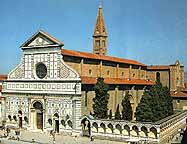
The centre nave
The interior of Santa Maria Novella is built on a Latin cross on the lines of the Cistercian-Gothic style which was imported from France but modified by the Italian mendicant Orders (the Franciscans and the Dominicans), in order to make it easier to preach to large numbers of worshippers. The interior is therefore divided up into three naves (the centre nave is 100 metres long), without chapels, and develops into a much larger area around the apse, particularly noticeable from Piazza Stazione. Like the Franciscan church of Santa Croce, the chapels are situated at the two far ends of the transept and in the area around the apse, near the main altar. Cistercian churches instead tended to be built with a square rather than semicircular main apse. The two architect monks made use of a special device in order to increase the strong perspective effect that was so popular in Italy; they did this by gradually reducing the size of the six arches in the naves (from 15 to 11,5 metres) along the approach to the altar; from the fourth arch onwards, two steps raise the height of the floor of the chancel and add to the overall "horizontal" effect. The Chapel of the Pure (dedicated to a miraculous painting of the Madonna) is situated at the end of the righthand nave and gives on to the Cemetery of Plaona, while the Sacristy can be found at the end of the lefthand nave. The entrance to the Cloisters from here is instead closed. The floor of the Basilica, which was relaid in the 19th century, at one time had at least 174 tomb stones set in it. The church has in fact been restored twice: the first restoration was commissioned in 1567 by Grand Duke Cosimo I under the direction of Giorgio Vasari, while the second was carried out by architect Enrico Romoli between 1858 and 1860.
